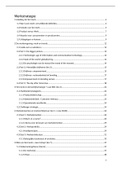Summary
Summary 4.3 Severe Mental Illness Lectures and Notes
- Course
- Institution
Comprehensive set of notes that covers all lectures/articles/chapters of the Slade book. These notes helped me achieve a 9.4 in the exam (and a 9.0 summa cum laude in the master overall). They are very detailed, so they are not to be treated as a quick summary, but rather as a substitute for any re...
[Show more]












